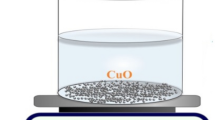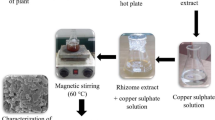Abstract
Conventional water treatment tools have a great deal of difficulty in attempting to remove such contaminants. Green-derived palladium nanoparticles have been used as a photocatalyst in this study to break down fabric dye in an aqueous environment utilizing visible light irradiation. Palladium nanoparticles were developed using a sustainable strategy and cumin Cuminum extract. Pd NPs’ (111), (200), (220), and (311) interlayer planes corresponding to the diffraction peaks at 2θ values were 38.9°, 45.2°, 65.4°, and 82°. Pd NPs may include phyto-chemicals or anti-oxidants in herbal extract, as shown by blue emission with an emission peak at 480 nm and an excitation peak at 460 nm. SEM analysis confirmed that the size of the PdNPs was 13 nm, and it is spherical and tubular rods. The rod-like formations may be seen to have particle diameters between 12 and 22 nm from TEM analysis. The object’s diffraction fringe is consistently metallic Pd in the face-centered cubic stage, with a period of 0.245 nm. The deletion of the UV absorption peak at 519 nm revealed that the saffranin O dye had been eliminated. Considering a quantum yield of m = 2.37 s−1, efficient decolorization of palladium nanoparticles was estimated to be 98% after 90 min. In addition, the photodegradation was shown to use the Langmuir–Hinshelwood kinetic approach, as shown by the regression model’s R2 of 0.98. The maximal diameter of the hindrance zone for Escherichia coli was determined to be 24 mm, especially at lower concentrations (10 µl/ml).











Similar content being viewed by others
Data availability
The datasets generated during and/or analyzed during the current study are available from the corresponding author on reasonable request.
References
Velusamy S, Roy A, Sundaram S, Mallick TK (2021) A review on heavy metal ions and containing dyes removal through graphene oxide-based adsorption strategies for textile wastewater treatment. Chem Rec 21(7):1570–1610
Ghodke SA, Sonawane SH, Bhanvase BA, Potoroko I (2018) Advanced engineered nanomaterials for the treatment of wastewater. In: Handbook of nanomaterials for industrial applications. Elsevier, pp 959–970
Shah A, Shahzad S, Munir A, Nadagouda MN, Khan GS, Shams DF, Dionysiou DD, Rana UA (2016) Micelles as soil and water decontamination agents. Chem Rev 116(10):6042–6074
Kanatzidis MG, Poeppelmeier KR, Bobev S, Guloy AM, Hwu S-J, Lachgar A, Latturner SE et al (2008) Report from the third workshop on future directions of solid-state chemistry: the status of solid-state chemistry and its impact in the physical sciences. Prog Solid State Chem 36(1–2):1–133
Chadha U, Bhardwaj P, Agarwal R, Rawat P, Agarwal R, Gupta I, Panjwani M et al (2022) Recent progress and growth in biosensors technology: a critical review. J Ind Eng Chem
Hussain I, Singh NB, Singh A, Singh H, Singh SC (2016) Green synthesis of nanoparticles and its potential application. Biotechnol Lett 38:545–560
Seabra AB, Haddad P, Duran N (2013) Biogenic synthesis of nanostructured iron compounds: applications and perspectives. IET Nanobiotechnol 7(3):90–99
Vishnukumar P, Vivekanandhan S, Muthuramkumar S (2017) Plant-mediated biogenic synthesis of palladium nanoparticles: recent trends and emerging opportunities. ChemBioEng Reviews 4(1):18–36
Momeni S, Nabipour I (2015) A simple green synthesis of palladium nanoparticles with Sargassum alga and their electrocatalytic activities towards hydrogen peroxide. Appl Biochem Biotechnol 176:1937–1949
Han J-W, Zheng H-F, Cui Y, Sun L-D, Ye D-Q, Zhi H, Jin-Hua X et al (2009) Genome-wide association study in a Chinese Han population identifies nine new susceptibility loci for systemic lupus erythematosus. Nat Genet 41(11):1234–1237
Anand P, Kunnumakkara AB, Newman RA, Aggarwal BB (2007) Bioavailability of curcumin: problems and promises. Mol Pharm 4(6):807–818
Boomi P, Poorani GP, Selvam S, Palanisamy S, Jegatheeswaran S, Anand K, Balakumar C, Premkumar K, Prabu HG (2020) Green biosynthesis of gold nanoparticles using Croton sparsiflorus leaves extract and evaluation of UV protection, antibacterial and anticancer applications. Appl Organomet Chem 34(5):e5574
Sheny DS, Philip D, Mathew J (2012) Rapid green synthesis of palladium nanoparticles using the dried leaf of Anacardium occidentale. Spectrochim Acta A Mol Biomol Spectrosc 91:35–38
Panneerselvam A, Velayutham J, Ramasamy S (2021) Green synthesis of TiO2 nanoparticles prepared from Phyllanthus niruri leaf extract for dye adsorption and their isotherm and kinetic studies. IET Nanobiotechnol 15(2):164–172
Jeevanantham V, Tamilselvi D, Bavaji SR et al (2023) Green formulation of gold nanoparticles and their antioxidative assays, antimicrobial activity and photocatalytic colour decay. Bull Mater Sci 46:32
Castro L, Luisa Blázquez M, Muñoz JA, González F, García-Balboa C, Ballester A (2011) Biosynthesis of gold nanowires using sugar beet pulp. Process Biochem 46(5):1076–1082
Vigneshwaran N, Ashtaputre NM, Varadarajan PV, Nachane RP, Paralikar KM, Balasubramanya RH (2007) Biological synthesis of silver nanoparticles using the fungus aspergillus flavus. Mater Lett 61(6):1413–1418
Sivamaruthi BS, Ramkumar VS, Archunan G, Chaiyasut C, Suganthy N (2019) Biogenic synthesis of silver palladium bimetallic nanoparticles from fruit extract of Terminalia chebula–in vitro evaluation of anticancer and antimicrobial activity. J Drug Deliv Sci Technol 51:139–151
Jeevanantham V, Tamilselvi D, Radhidevi K, Bavaji SR (2023) Greener microwave synthesized se nanospheres for antioxidant, cell viability, and antibacterial effect. J Mater Res:1–10
Kalimuthu K, Babu RS, Venkataraman D, Bilal M, Gurunathan S (2008) Biosynthesis of silver nanocrystals by bacillus licheniformis. Colloids Surf B: Biointerfaces 65(1):150–153
Gopinatha P, Suresh P, Jeevanantham V (2023) Mechanical, structural and optical properties of pristine and PVA capped zinc oxide nanocomposites. J Ovonic Res 19(1):23–30
Pal A, Shah S, Devi S (2009) Microwave-assisted synthesis of silver nanoparticles using ethanol as a reducing agent. Mater Chem Phys 114(2–3):530–532
Lu W, Gao S, Wang J (2008) One-pot synthesis of ag/ZnO self-assembled 3D hollow microspheres with enhanced photocatalytic performance. J Phys Chem C 112(43):16792–16800
Manojkumar MS, Jeyajothi K, Jagadeesan A, Jeevanantham V (2022) Magnetic separation of green synthesized Fe3O4 nanoparticles on photocatalytic activity of methyl orange dye removal. J Indian Chem Soc 99(8):100559
Wu Z, Chengrong X, Yaqin W, Hao Y, Tao Y, Wan H, Gao F (2013) ZnO nanorods/ag nanoparticles heterostructures with tunable ag contents: a facile solution-phase synthesis and applications in photocatalysis. CrystEngComm 15(30):5994–6002
Chen X, Zheng Z, Ke X, Jaatinen E, Xie T, Wang D, Guo C, Zhao J, Zhu H (2010) Supported silver nanoparticles as photocatalysts under ultraviolet and visible light irradiation. Green Chem 12(3):414–419
Arul S, Senthilnathan T, Jeevanantham V, Satheesh Kumar KV (2021) Pseudocapacitive characteristics of mg doped Zno Nanospheres prepared by Coprecipitation. Arch Metall Mater 66(4):1141–1148
Ramteke C, Chakrabarti T, Sarangi BK, Pandey RA (2013) Synthesis of silver nanoparticles from the aqueous extract of leaves of Ocimum sanctums for enhanced antibacterial activity. J Chem Article ID 278925, p. 7
Jagadeeswari R, Selvakumar P, Jeevanantham V, Saravanan R (2021) Chemically modified cellulose capped zinc oxide nanocomposite: spectral and optical properties. Arch Metall Mater 66(3):911–915
Linga RM, Savithramma N (2012) Antimicrobial activity of silver nanoparticles synthesized by using stem extract of Svensonia hyderobadensis (Walp.) mold-a rare medicinal plant. Res Biotechnol 3(3):41–47
Prabhu N, Divya TR, Yamuna G (2010) Synthesis of silver phyto nanoparticles and their antibacterial efficacy. Dig J Nanomater Biostructures 5(1):185–189
Savithramma N, Linga Rao M, Rukmini K, Suvarnalatha Devi P (2011) Antimicrobial activity of silver nanoparticles synthesized by using medicinal plants. Int J ChemTech Res 3(3):1394–1402
Author information
Authors and Affiliations
Contributions
V. J., D. T., K. R., and P. N. carried out the experiment. V. J. wrote the manuscript with support from D. T. and K. R. P. N. helped supervise the project.
Corresponding author
Ethics declarations
Ethical approval
Not applicable
Competing interests
The authors declare no competing interests.
Additional information
Publisher's note
Springer Nature remains neutral with regard to jurisdictional claims in published maps and institutional affiliations.
Rights and permissions
Springer Nature or its licensor (e.g. a society or other partner) holds exclusive rights to this article under a publishing agreement with the author(s) or other rightsholder(s); author self-archiving of the accepted manuscript version of this article is solely governed by the terms of such publishing agreement and applicable law.
About this article
Cite this article
Jeevanantham, V., Tamilselvi, D., Rathidevi, K. et al. Green formulation of palladium nanoparticles on photocatalytic behavior of fabric dyes removal and its antibacterial assay. Biomass Conv. Bioref. (2023). https://doi.org/10.1007/s13399-023-04179-9
Received:
Revised:
Accepted:
Published:
DOI: https://doi.org/10.1007/s13399-023-04179-9




